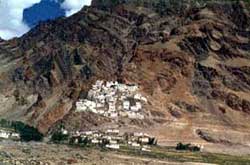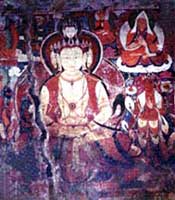Karsha -
The largest monastery of Zanskar, Karsha Gompa is an imposing complex of neatly white washed building blocks comprising several chapels, besides residential cells for its nearly 150 lamas, who belong to the Geluks-pa sect.
 |
|
Built picturesquely along the steeply rising mountainside above Karsha village, the monastery can be seen from far. The central building is a large assembly hall housing an array of figures and the ornate throne of the Head Lama-incarnate. Three adjoining chapels contain numerous statues and other art objects, among which a set of exquisite silver and copper chortens are worth noting for their beauty. Of particular interest in the complex is the Lhabrang, a large temple accessible through a vent in the roof, whose partially damaged walls are still adorned with the original frescos believed to be more than 300 years old. The event to witness at Karsha is the 3-day Gustor festival held in early July when thousands of devotees throng the monastery to witness the mask dances performed by the lamas.
| |
 |
Other places of interest in the Karsha area include an old nunnery called Dorje Dzong, occupying a hilltop to the west of the main monastery. The ruins around this nunnery are believed to be the original monastic foundation of Karsha: the present monastery was founded during the 14th century. An old stupa surviving among the ruins is still adorned with the original murals, which reflect Indian artistic influence. Nearby is the ancient temple of 'Chukshik-jal', which houses an exquisite figure of Avalokitesvara as the main image. Its smoke covered wall frescos are the finest example of Himalayan art.
Karsha can be approached from Padum by the 9 km long link road, across an iron bridge over the Stod river. It can also be approached directly from the Tungri bridgehead along a 17-km link road that branches off from the Kargil-Padum road at Tungri, about 12 kms before Padum.
|
